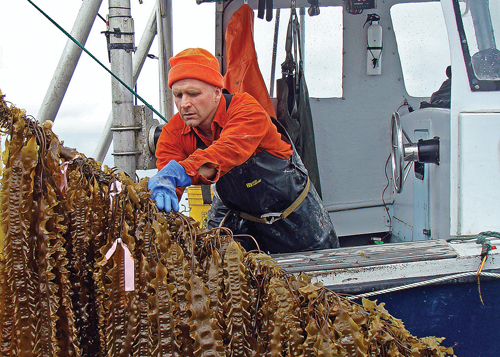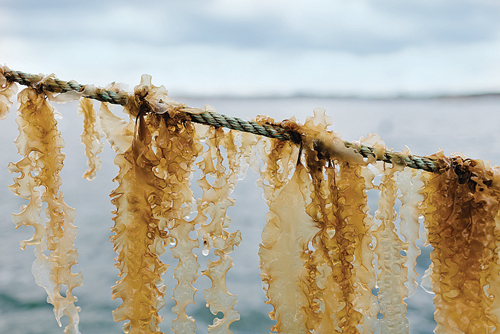Kelp, a slippery seaweed, could be major moneymaker

It’s a delicacy Asian cultures have enjoyed for centuries but is more commonly thought of as the slippery — and sometimes slimy — brown stuff that grows naturally in area waters and then washes up on beaches.
And one day, it could be a major moneymaker for the North Fork.
Though regional cash crops are typically cultivated on land, aquaculturists are pushing state and county lawmakers to permit the growing and selling of sugar kelp, or seaweed. They say the salty yet sweet leafy sea vegetable could benefit the economy, the environment, and even put baymen back to work at a time when making a living on the water is becoming increasingly difficult.
Researchers have suggested that farming kelp in Long Island Sound waters has the potential to produce annual sales of $47 million, according to County Executive Steve Bellone’s office. But in order for sugar kelp to be farmed in Peconic Bay and Sound waters — where many of the state’s aquaculture farms are located — state and county lawmakers need to make regulatory changes to allow it.
Currently, state law allows only for shellfish cultivation in these areas.
Cornell Cooperative Extension of Suffolk County is exploring the idea of growing the kelp industry locally and hopes to partner with researchers from the University of Connecticut on a study in Orient Harbor — if it can find the funds to do so.
Uncharted waters
“It’s exciting,” Southold aquaculturist Karen Rivara said of the industry’s potential while giving Mr. Bellone a tour of the Peconic Land Trust’s Shellfisher Preserve on Southold Bay last month. Ms. Rivara, who owns Aeros Cultured Oyster Company, is also president of the Long Island Farm Bureau. She is the organization’s first aquaculturist to hold that title. “I think it’s hard to find a reason not to do it.”
Area waters already ideal for growing shellfish are also perfect for kelp cultivation, she said, and would allow aquatic farmers another crop to harvest when the shellfish industry slows down, since kelp grows in the winter. The two can be grown in the same underwater space.
Ms. Rivara said the ultimate benefit of kelp is that it thrives on nitrogen, sucking up the very culprit wreaking havoc on the same waters, feeding harmful algal blooms and depriving waters of oxygen.
Growing shellfish and kelp side by side, she explained, would help protect her shellfish from being polluted by harmful algal blooms — one particular variety can cause paralytic shellfish poisoning in humans — and allow her to make a few bucks in the process.

Environmental benefits to be had
“The darker the color, the more nitrogen [the kelp] is soaking up,” said Bren Smith, a Connecticut kelp farmer who grows his product in Long Island Sound waters and is banking on the sugar kelp industry to take off. A vocal advocate of kelp’s growth potential, Mr. Smith owns Thimble Island Oysters and — as Ms. Rivara hopes to do — grows his shellfish and kelp within a single ecosystem.
And it just so happens that the darker the kelp’s color, the richer and sweeter its flavor, said UCONN professor Charlie Yarish, who has been studying seaweed cultivation for several decades.
“It is really a way of restoring the environment while making a product we can eat,” he said.
Sugar kelp is produced when reproductive cells, known as spores, are collected from kelp already occurring naturally in local waters, Mr. Yarish explained.
The cells are retrieved from the leafy greens in a lab and settled on a string where they continue to reproduce, essentially growing off the string. The string is then wrapped around a rope and submerged horizontally across bay waters, where the kelp continues to grow by feeding on nitrogen already abundant in Peconic Bay and Sound waters.
“The kelp starts to grow vertically, and it grows very quickly, as soon as the water drops below 50 degrees,” said Mr. Smith, who uses this exact process.
In December, January and February, kelp grows rapidly, sucking up nitrogen before phytoplankton — which multiply in warmer waters, eventually causing algal blooms — can begin feeding on it, Mr. Yarish said.
He said he developed the cultivation process with financial support from the Connecticut Sea Grant College Program and has passed his knowledge on to growers like Mr. Smith.
He hopes to one day mentor New York cultivators as well.
A growing market
According to a 2010 United Nations State of the World Fisheries and Aquaculture report, “countries in East and Southeast Asia dominate seaweed culture production (99.8 percent by quantity and 99.5 percent by value, according to 2008 data).”
China, Indonesia and the Philippines lead the way, accounting for over 85 percent of kelp production.
The U.S., however, has lagged behind, as only a handful of growers currently cultivate it nationwide and are located mostly in New England. As a result, it’s had to import nearly all of its kelp meant for human consumption.
“I know that seaweed farming in Asian countries has been prolific,” said Assemblyman Anthony Palumbo (R-New Suffolk), whose district spans the North Fork. “To kind of expand on that here, I think, is a great idea.”
Demand for a domestically grown product safe from contaminants is growing, Mr. Smith said. He added that his company’s 18-ton-a-year kelp yield — for which he earns about 35 cents per pound, when wet — is nowhere near filling increasing domestic demand.
Companies including Whole Foods Market are working to incorporate kelp into other products, as a way of expanding the market, Mr. Yarish said. Because kelp has a very short shelf life when gathered fresh from the sea, freezing or incorporating it into other products is a way of preserving it.
The question is, “How do we take this weird thing and get it on the kitchen table?” Mr. Smith said. “How can we make kelp the new kale, which is now on every restaurant menu?”
Sugar kelp is rich in calcium, folic acid and vitamins A, B, D, E and K, according to multiple research studies. As a result, it’s been touted by many health food outlets as the next “superfood.”
Because of this, it has potential not only for the dinner table but also in pharmaceutical and cosmetic markets.
It’s also high in iodine, which is commonly used in supplements given to people with thyroid problems, according to New York University hospital researchers.
Kelp extract is also added to skin care products, helping to give the appearance of firmer skin.
And because it sucks up all that nitrogen, it can also be used as a natural fertilizer, Mr. Yarish said.
Mr. Smith said he hopes land farmers will consider using the seaweed as fertilizer and stop using synthetic forms of nitrogen on land, which inevitably makes its way into area waters.
“We’re taking land- and sea-based farming and trying to close the nitrogen loop,” he said. What’s being done now
Cultivating kelp in town or privately owned waters and creeks wouldn’t require a change in law, said Chris Pickerell, director of Cornell’s marine program. However, state-owned lands — where many local aquaculture farms exist — would need to amend current legislation to allow for seaweed cultivation.
Ms. Rivara is one of more than 40 growers taking advantage of state-owned land through Suffolk County’s Shellfish Aquaculture Lease Program, which gives area growers access to underwater lands for farming in the Peconic Bay.
Many other shellfish farmers operate on state-owned lands leased in the Long Island Sound, she said. Currently, she said, there’s no way to apply for a permit for seaweed cultivation on state-controlled lands.
“We don’t have the legal mechanism to do it,” she said.
Mr. Pickerell said that “In the simplest sense, it is a matter of adding the words ‘seaweed cultivation’ into the current law.”
He said he’s been working with County Legislator Al Krupski (D-Cutchogue) and state Assemblymen Fred Thiele (I-Sag Harbor) to create legislation to change the law. Ms. Rivara has spoken with Mr. Bellone in hopes of initiating the change.
Senator Ken LaValle (R-Port Jefferson) said a kelp industry would “both lead to job creation and stimulate our economy, while cleaning our waters.”
In a letter supporting Cornell’s pilot cultivation study, Mr. Bellone called the industry’s potential “an extremely interesting, and potentially lucrative, economic development opportunity.” He added that the program will help “develop policies that can help grow and support the industry.”
Cornell has applied for grant funding from both the National Oceanic and Atmospheric Administration and the New York State Energy Research and Development Authority’s Cleaner, Greener Communities grant program. It hopes to raise enough money to plan, design, construct and acquire the equipment necessary for a start-up kelp farm.
Mr. Palumbo said, “I would like to see the results of the program so we can see how to manage it [the industry] properly, to find that happy medium so that we can both reduce nitrogen and produce an additional product that can be sold,” adding that the right environmental groups are involved in the project.
From a community standpoint, Mr. LaValle said, the project “will help ensure the maritime industry of aquaculture remains viable, and create new opportunities for the next generation to work on the water.”
He said he has written a letter to the state, which runs NYSERDA, in hopes of receiving project funding from them.
“This is a win-win for everything,” Mr. Pickerell said. “We need to get all of our ducks in a row in terms of the regulatory approvals.”

